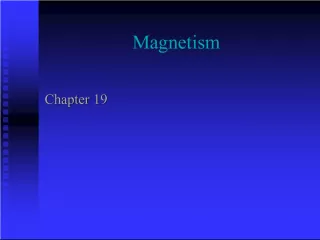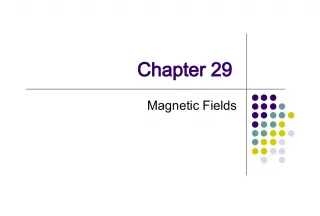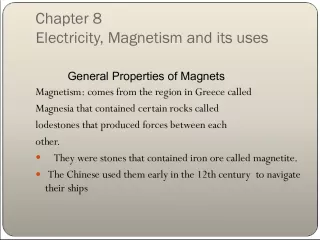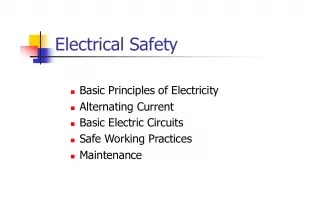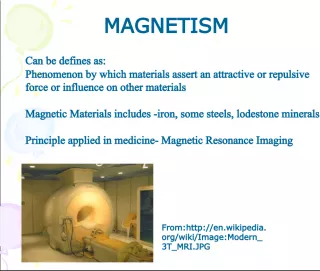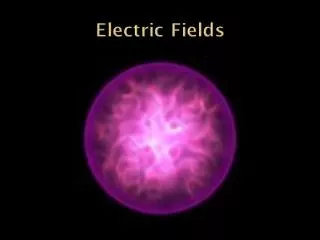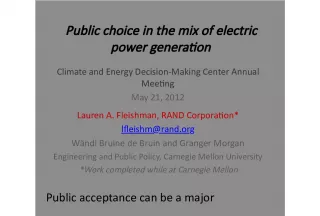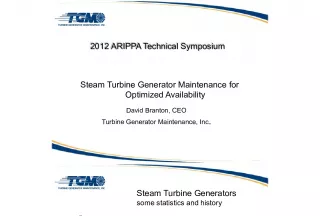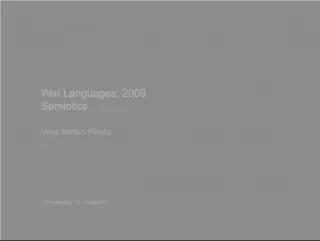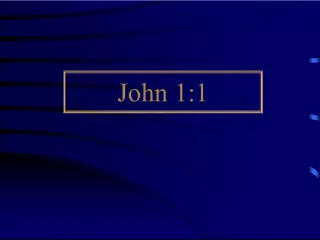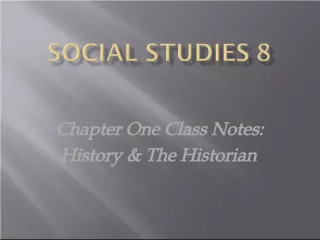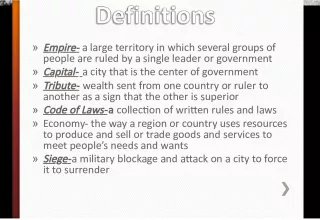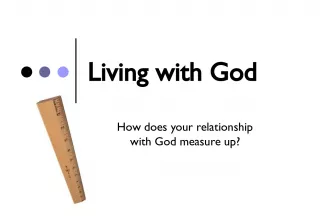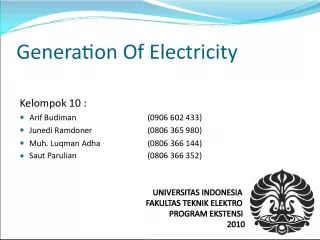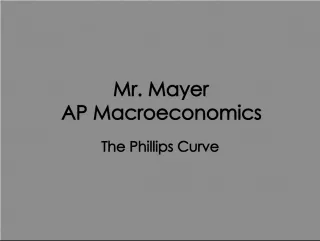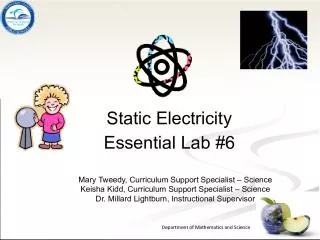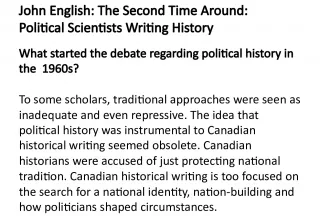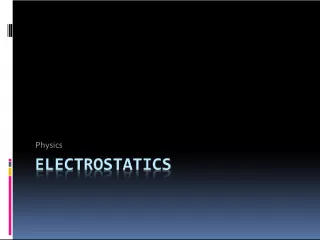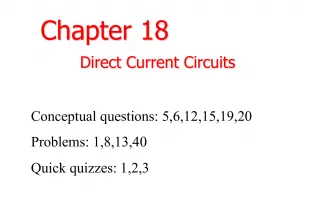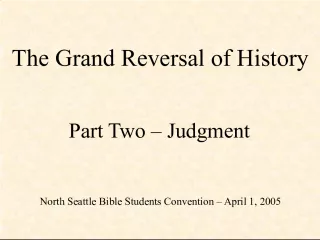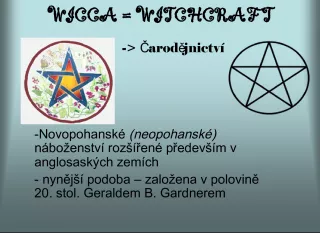The Relationship between Electricity and Magnetism: A Little History


Before the 19th century, scientists believed electricity and magnetism were unrelated. In 1820, Hans Christian Oersted demonstrated that passing electric current near a magnetic compass caused the needle to move, revealing a connection between the two forces.
- Uploaded on | 3 Views
-
 elliewalker
elliewalker
About The Relationship between Electricity and Magnetism: A Little History
PowerPoint presentation about 'The Relationship between Electricity and Magnetism: A Little History'. This presentation describes the topic on Before the 19th century, scientists believed electricity and magnetism were unrelated. In 1820, Hans Christian Oersted demonstrated that passing electric current near a magnetic compass caused the needle to move, revealing a connection between the two forces.. The key topics included in this slideshow are . Download this presentation absolutely free.
Presentation Transcript
1. Magnetism Magnetism Physics Physics
2. A little history… A little history… Until the early 19 th century, scientists thought electricity and magnetism were unrelated Until the early 19 th century, scientists thought electricity and magnetism were unrelated In 1820, Danish science professor Hans Christian Oersted was demonstrating electric currents in front of a class of students In 1820, Danish science professor Hans Christian Oersted was demonstrating electric currents in front of a class of students When electric current was passed in a wire near a magnetic compass, the compass needle moved When electric current was passed in a wire near a magnetic compass, the compass needle moved Electricity and Magnetism are related! Electricity and Magnetism are related!
3. Comparing E&M Comparing E&M Magnets exert forces on one another Magnets exert forces on one another Similar to electric charges: Similar to electric charges: Can attract and repel without touching Can attract and repel without touching Strength of interaction depends on the distance of separation of the two magnets Strength of interaction depends on the distance of separation of the two magnets Different from electric charges: Different from electric charges: Electric charges produce electrical forces Electric charges produce electrical forces Regions called magnetic poles produce magnetic forces Regions called magnetic poles produce magnetic forces
4. Magnetic Poles Magnetic Poles All magnets have both a north and a south pole All magnets have both a north and a south pole Like poles repel Like poles repel Opposite poles attract Opposite poles attract Magnetic poles always exist in pairs Magnetic poles always exist in pairs
5. Magnetic Fields Magnetic Fields Magnetic Field (B) : The space around a magnet in which a magnetic force is exerted [measured in Tesla – T]. Magnetic Field (B) : The space around a magnet in which a magnetic force is exerted [measured in Tesla – T]. Magnetic Field is a VECTOR (has magnitude and direction). Magnetic Field is a VECTOR (has magnitude and direction). The direction of the magnetic field outside a magnet is from the north to the south pole The direction of the magnetic field outside a magnet is from the north to the south pole N N S S B Field
6. Magnetic Domains Magnetic Domains Magnetic Domain = large clusters of atoms lined up with each other Magnetic Domain = large clusters of atoms lined up with each other Domains start out randomly oriented in this piece of iron Domains start out randomly oriented in this piece of iron Domains align in the direction of the magnetic field as they are brought closer to a magnet Domains align in the direction of the magnetic field as they are brought closer to a magnet Permanent magnets are made by placing pieces of iron or certain iron alloys in strong magnetic fields Permanent magnets are made by placing pieces of iron or certain iron alloys in strong magnetic fields
7. How are E&M related? How are E&M related? Charges in motion have both E (electric) fields and B (magnetic) fields associated with them Charges in motion have both E (electric) fields and B (magnetic) fields associated with them In a bar magnet, electrons inside are constantly moving In a bar magnet, electrons inside are constantly moving Moving charge = current magnetic field Moving charge = current magnetic field Electrons also spin Electrons also spin Spinning charge =motion magnetic field Spinning charge =motion magnetic field Moving electric charges create magnetic fields Moving electric charges create magnetic fields
8. Electromagnets Electromagnets If a current carrying wire is bent into a loop, the magnetic field lines become bunched up inside the loop If a current carrying wire is bent into a loop, the magnetic field lines become bunched up inside the loop A current-carrying coil of wire with many loops is an electromagnet A current-carrying coil of wire with many loops is an electromagnet
9. The Right Hand Rule The Right Hand Rule To find the direction of the magnetic field in a wire, point the thumb/fingers of your right hand in the direction of current flow. To find the direction of the magnetic field in a wire, point the thumb/fingers of your right hand in the direction of current flow. Your fingers/thumb point in the direction of the magnetic field. Your fingers/thumb point in the direction of the magnetic field. Out of the page Into the page
10. The Right Hand Rule The Right Hand Rule What is the direction of the magnetic field in this wire? What is the direction of the magnetic field in this wire? What is the direction of the magnetic field in this coil or wire? What is the direction of the magnetic field in this coil or wire?
11. ANSWERS ANSWERS What is the direction of the magnetic field in this wire? What is the direction of the magnetic field in this wire? What is the direction of the magnetic field in this coil or wire? What is the direction of the magnetic field in this coil or wire? B Field B Field
12. Force is greatest when the particle moves perpendicular to the magnetic field Force is greatest when the particle moves perpendicular to the magnetic field Force becomes less at angles less than 90 and zero when the particle moves parallel to the field lines Force becomes less at angles less than 90 and zero when the particle moves parallel to the field lines When MOVING electric charges are placed in magnetic fields, they feel a FORCE. When MOVING electric charges are placed in magnetic fields, they feel a FORCE.
13. Magnetic Force Magnetic Force The force that acts on a moving charged particle depends on the particle’s charge , its velocity , and the strength of the magnetic field . The force that acts on a moving charged particle depends on the particle’s charge , its velocity , and the strength of the magnetic field . B = magnetic field [T] B = magnetic field [T] v = charge velocity [m/s] v = charge velocity [m/s] F = force [N] F = force [N] q = charge [C] q = charge [C] F = qvB F = qvB
14. The Right Hand Rule The Right Hand Rule To find the direction of the magnetic force on a charge To find the direction of the magnetic force on a charge Take two pens Take two pens Hold them perpendicular to each other as in the picture Hold them perpendicular to each other as in the picture Take your RIGHT hand Take your RIGHT hand Place your RIGHT hand at the point where the two pens meet Place your RIGHT hand at the point where the two pens meet Push v towards B Push v towards B The direction your thumb points is the direction of F The direction your thumb points is the direction of F Out of the page Into the page
15. Right Hand Rule Practice Right Hand Rule Practice v v v B B B
16. Magnetic Force cont’d Magnetic Force cont’d Now we know: Now we know: a charged particle moving through a magnetic field experiences a deflecting force a charged particle moving through a magnetic field experiences a deflecting force So… So… a current of charged particles moving through a magnetic field also experiences a deflecting force a current of charged particles moving through a magnetic field also experiences a deflecting force F = force (N) I = current (A) L = length of wire (m) B = magnetic field (T) F = ILB F = ILB
17. Magnetic Force Magnetic Force When an electric charge moves in a magnetic field, it feels a force. When an electric charge moves in a magnetic field, it feels a force. Single charge: Many charges (current): Single charge: Many charges (current): F = qvB F = qvB F = ILB F = ILB F = force (N) I = current (A) L = length of wire (m) B = magnetic field (T) F = force (N) q = charge (C) v = velocity (m/s) B = magnetic field (T)
18. Earth’s B Field Earth’s B Field A compass points northward because Earth itself is a huge magnet A compass points northward because Earth itself is a huge magnet The compass aligns with the magnetic field of the earth The compass aligns with the magnetic field of the earth Most geologists think that moving charges looping around within Earth create its magnetic field Most geologists think that moving charges looping around within Earth create its magnetic field The magnetic field of Earth is not stable The magnetic field of Earth is not stable It has flip- flopped throughout geologic time It has flip- flopped throughout geologic time Studies of deep-sea sediments indicate that the field was virtually switched off for 10,000 to 20,000 years just over 1 million years ago Studies of deep-sea sediments indicate that the field was virtually switched off for 10,000 to 20,000 years just over 1 million years ago
19. Electromagnetic Induction Electromagnetic Induction Physics Physics magnetism can produce electricity & electricity can produce magnetism magnetism can produce electricity & electricity can produce magnetism
20. Electromagnetic Induction Electromagnetic Induction Electric current can be produced in a wire by simply moving a magnet into or out of a wire Electric current can be produced in a wire by simply moving a magnet into or out of a wire Movement of the magnet induces a voltage, which causes current flow Movement of the magnet induces a voltage, which causes current flow Voltage is induced whether the magnet is moved through the wire or the wire is moved through the magnet Voltage is induced whether the magnet is moved through the wire or the wire is moved through the magnet
21. Flux Flux Magnetic Flux = the number of magnetic field lines passing through a given area Magnetic Flux = the number of magnetic field lines passing through a given area Measured in Webers (Wb) Measured in Webers (Wb) If a loop of wire lies perpendicular to a magnetic field, the maximum possible number of lines of flux will pass through the loop. If a loop of wire lies perpendicular to a magnetic field, the maximum possible number of lines of flux will pass through the loop. If the loop of wire lies parallel to the field, the flux through the loop will be zero. If the loop of wire lies parallel to the field, the flux through the loop will be zero. Φ = AB Φ = AB Φ = flux (Wb) A = area of loop (m2) B = magnetic field (T) Φ = flux (Wb) A = area of loop (m2) B = magnetic field (T)
22. Example Example Eleanor is undergoing an MRI procedure and is placed inside a chamber housing the coil of a large electromagnet that has a radius of 25.0 cm. A flux of 0.290 Wb passes through the coil opening. What is the magnetic field inside the coil? Eleanor is undergoing an MRI procedure and is placed inside a chamber housing the coil of a large electromagnet that has a radius of 25.0 cm. A flux of 0.290 Wb passes through the coil opening. What is the magnetic field inside the coil?
23. greater number of loops of wire = greater induced voltage = greater current greater number of loops of wire = greater induced voltage = greater current greater number of loops of wire = greater induced voltage = greater current greater number of loops of wire = greater induced voltage = greater current Faraday’s Law : Induced voltage in a coil is proportional to: the product of the number of loops the cross-sectional area of each loop and the rate at which the magnetic field changes within those loops
24. Example Example The hood ornament on Abe’s sedan is shaped like a ring 8.00 cm in diameter. Abe is driving toward the west so that Earth’s 5.00*10 -5 T field provides no flux through the hood ornament. What is the induced voltage in the metal ring as Abe turns from this street onto one where he is traveling north, if he takes 3.0 s to make the turn? The hood ornament on Abe’s sedan is shaped like a ring 8.00 cm in diameter. Abe is driving toward the west so that Earth’s 5.00*10 -5 T field provides no flux through the hood ornament. What is the induced voltage in the metal ring as Abe turns from this street onto one where he is traveling north, if he takes 3.0 s to make the turn? Φ = AB Φ = AB
25. Lenz’s Law Lenz’s Law An induced voltage always produces a magnetic field that opposes the field that originally produced it An induced voltage always produces a magnetic field that opposes the field that originally produced it In other words: In other words: If the original magnetic field, and thus the flux, is going toward the north, the induced voltage will produce an opposing field and flux that goes toward the south If the original magnetic field, and thus the flux, is going toward the north, the induced voltage will produce an opposing field and flux that goes toward the south
26. Generators & Motors Generators & Motors Generator = A machine that produces electric current by rotating a coil within a stationary magnetic field Generator = A machine that produces electric current by rotating a coil within a stationary magnetic field A motor converts electrical energy into mechanical energy. A motor converts electrical energy into mechanical energy. A generator converts mechanical energy into electrical energy. A generator converts mechanical energy into electrical energy.
28. Transformers Transformers A transformer works by inducing a changing magnetic field in one coil, which induces an alternating current in a nearby second coil A transformer works by inducing a changing magnetic field in one coil, which induces an alternating current in a nearby second coil Voltages may be stepped up or stepped down with a transformer Voltages may be stepped up or stepped down with a transformer
29. Power Transmission Power Transmission Power is transmitted great distances at high voltages and correspondingly low currents, a process that otherwise would result in large energy losses owing to the heating of the wires. Power is transmitted great distances at high voltages and correspondingly low currents, a process that otherwise would result in large energy losses owing to the heating of the wires. Power may be carried from power plants to cities at about 120,000 volts or more, stepped down to about 2400 volts in the city, and finally stepped down again by a transformer to provide the 120 volts in our houses Power may be carried from power plants to cities at about 120,000 volts or more, stepped down to about 2400 volts in the city, and finally stepped down again by a transformer to provide the 120 volts in our houses
